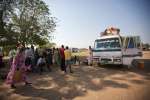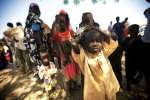- Text size
 |
|  |
|  |
| 
- Français
South Sudanese refugees moved from flood-prone camp in Ethiopia
News Stories, 15 May 2015
JEWI REFUGEE CAMP, Ethiopia, May 15 (UNHCR) – The night after Nyadal Dak arrived in Nip Nip refugee camp from South Sudan with her three children and an orphaned niece, it began to rain. Soon the place was flooded. That was August 2014 and the 26-year-old recalled: "Every time it rained in Nip Nip, I feared that the place would be flooded again."
So she was delighted last week when the Ethiopian government, UNHCR and the International Organization for Migration relocated some 2,200 South Sudanese refugees from flood-prone Nip Nip to Jewi Camp in western Ethiopia's Gambella region. In the new camp, the refugees are assured of better humanitarian services and access to education for their children.
A further 48,000 refugees are being moved from the Leitchour camp, located near Nip Nip and also prone to flooding, at a rate of about 1,600 a day. The rainy season recently started and that number is expected to rise to 4,000 a day in a race to complete the operation before the flooding.
"If UNHCR had not relocated us, I was going to walk to this camp with my children," Nyadal said outside her tent in Jewi. With the May-October rainy season under way, she said: "I was living in fear and looking forward to the day I would relocate."
Like most other refugees here, she also worries about the situation back in South Sudan, which erupted in violence between government and rebel forces in December 2013, forcing more than 200,000 people to flee across the border into the Gambella region.
"The killing was everywhere. My sister and other family members were killed. We saw dead bodies and burnt down towns and villages as we were fleeing," said Nyadol, who comes from Upper Nile state. She also became separated from her husband and has no idea even if he is alive.
When she fled to Ethiopia with the four children, ranging in age from three months to six years, it took two weeks to walk to the border. In Nip Nip, they faced the new danger of flooding, which continued until October last year.
Nyadol struggled to find a place to sleep at night, cooking was another problem. "I had a baby to take care of while constantly keeping my eyes on the other children. I was living in fear of my children drowning in the floodwaters," she said.
During the following dry weather, UNHCR and its partners worked to find a site on higher ground and then prepare a camp. When the camp was ready, the most vulnerable refugees such as Nyadol and her family were among the first to be moved.
Angele Djohossou, head of the UNHCR team in Gambella, recalled the difficulties. "The flooding was a very bad experience for both refugees and humanitarian workers," she said. "We had a refugee influx and we had the flooding. We had two emergencies. We had to use boats and a UNHCR-hired helicopter to provide services as roads were impassable."
Jewi camp has a capacity to shelter about 50,000 refugees. It will accommodate some 48,000 refugees from Leitchuor, and most of those from Nip Nip, which is now closed.
The International Organization for Migration is providing transport for the move from Leitchuor, which comes at a time when continued fighting in South Sudan is triggering new arrivals into Gambella.
Nyadol is confident she will not have to navigate floodwaters this year in Jewi camp. "This place will not get flooded. I will stay here until UNHCR tells us that our country is peaceful and it is time to return home." That could be some time.
By Sulaiman Momodu in Jewi Refugee Camp, Ethiopia


















































